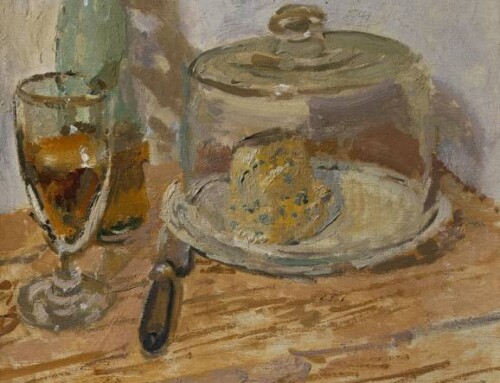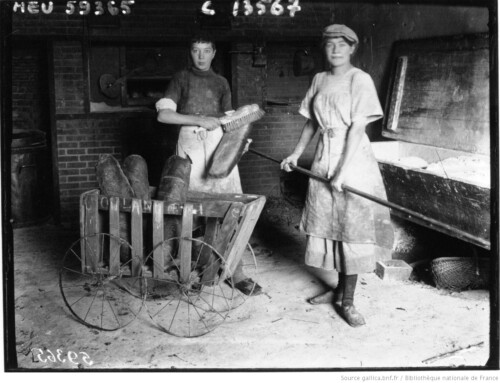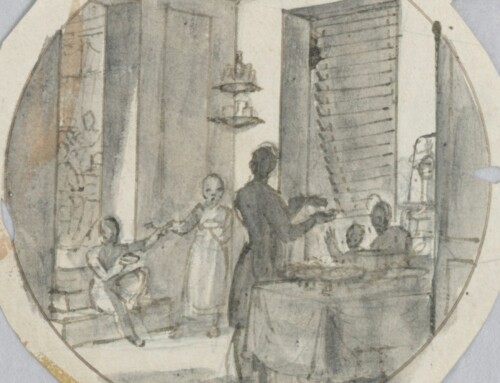Climate change has recently been disturbing coffee production in countries such as Cameroon, Haiti, and Côte d’Ivoire. The consumer’s concerns about reduced flavor quality and increased pricing for a cup of coffee (due to a diminishing supply of beans) become minor when compared to how extreme weather killing off coffee crops greatly reduces income for smallholder farmers in developing countries. According to a September 2016 report by the nonprofit Climate Institute, “Without strong action to reduce emissions, climate change is projected to cut the global area suitable for coffee production by as much as 50 per cent by 2050. By 2080, wild coffee, an important genetic resource for farmers, would become extinct” (Watts 1). If or when climate change leaves us with very few coffee beans, then what types of coffee substitute might we end up trying?
Consider how the French were still having “coffee” during periods of coffee shortage such as when Napoleon’s 1806 Continental System took place and World War II. Before Napoleon relaxed the blockade of British coffee shipments to France in November 1811, the French combined domestically grown chicory with what coffee they had left, and some even found chicory by itself to be a good enough drink. During World War II many people in Paris made “coffee” from roasted barley and chicory. A type of café national was made from acorns and chickpeas. The Nazis occupying France had ersatz coffee that had been created by chemists, such as a caffeinated acorn drink, for instance.
A method of making artificial coffee from chicory had been used in Holland for at least a century before two Frenchmen in 1801 learned of it and started using it: a Mister Orban in Liége and a Mister Giraud in Hornaing (near Valenciennes). In the June 1849 issue of the Journal de médecine, de chirurgie et de pharmacologie, an article by Alphonse Chevallier called “Falsifications du café-chicorée, son historique, sa fabrication, ses falsifications et des moyens de les reconnaître” notes that café-chicorée was sold under a variety of names: “les différents noms de café-chicorée gros grain, de chicorée royale, de chicorée poudre à canon, de semoule, de mignonette, de poudre superfine de moka, de moka en poudre, de café de dames, de crème de moka, de café pectoral, de café de Chartres, de café de santé, de café des îles, de café aux Chinois, de café aux Indiens, de café aux Javas, de café à la Tom-Pouce, de café à la polka, de café des colonies” (562). Several of these creative names do not reflect of course the fact that the chicory was grown in France.
But even before Mister Orban and Mister Giraud, another Frenchman had created a coffee substitute: Frenehard’s creation was made of rice, barley, rye, almonds, and sugar. An article in the September 1781 issue of the medical journal Gazette de Santé mentions that this coffee substitute can be a good option for anyone who has rheumatic pains and for insomniacs. This drink was sold under the name of café de santé. Frenehard’s “coffee” also received attention in a December 1781 issue of the Gazette du commerce and in a January 1782 issue of the Journal de l’agriculture, du commerce et des finances.
In the 1862 book Du café : son historique, son usage, son utilité, ses altérations, ses succédanés et ses falsifications, comprenant les condamnations prononcées contre les contrefacteurs, Chevallier notes that the high price of coffee during times of continental war inspired the French and others to come up with coffee substitutes, and he gives a list of the succédanés du café that appeared between 1761 and 1814. A rather peculiar one from 1825 that was proposed by a Mister Kait consisted of rye, eggs, and codfish skin (Chevallier 35). This drink was said to have appeared in the United States, and it was liked!
▀▄▀▄▀▄

James Gillray (1756–1815). The Plumb-Pudding in Danger;–or–State Epicures Taking un Petit Souper. 1805. The Metropolitan Museum of Art. → https://www.metmuseum.org/art/collection/search/367748
![Gautier. La Mort de la chicorée et de la betterave, ou la résurrection du sucre et du café [estampe]. 1814. Bibliothèque nationale de France. → https://catalogue.bnf.fr/ark:/12148/cb41515742r](https://henripeyrefi.ws.gc.cuny.edu/files/2017/09/La-Mort-De-La-Chicorée-Et-De-La-Betterave-Ou-La-Résurrection-Du-Sucre-Et-Du-Café-642x1024.jpeg)
Gautier. La Mort de la chicorée et de la betterave, ou la résurrection du sucre et du café [estampe]. 1814. Bibliothèque nationale de France. → https://catalogue.bnf.fr/ark:/12148/cb41515742r

Fabrique de chicorée de Charles Hecht, à Strasbourg, à la Gantzau près du Neuhof (TR). 1860. Bibliothèque nationale de France. → https://catalogue.bnf.fr/ark:/12148/cb41925460r
![Chicorée Paul Mairesse, Cambrai [affiche]. Circa 1894-1900. Public Domain. Bibliothèque historique de la ville de Paris / Roger-Viollet. → https://bibliotheques-specialisees.paris.fr/ark:/73873/pf0002141443/v0001.simple.selectedTab=record](https://henripeyrefi.ws.gc.cuny.edu/files/2017/09/Chicorée-Paul-Mairesse-Cambrai-1024x778.jpg)
Chicorée Paul Mairesse, Cambrai [affiche]. Circa 1894-1900. Public Domain. Bibliothèque historique de la ville de Paris / Roger-Viollet. → https://bibliotheques-specialisees.paris.fr/ark:/73873/pf0002141443/v0001.simple.selectedTab=record
![Amateurs de bon café. Goutez le moka japonais [affiche publicitaire]. B. Bourgeois, fabricant de chicorée à Proville-lez-Cambrai (Nord). 19th century. Bibliothèque nationale de France / Médiathèque de Chaumont. → https://silos.ville-chaumont.fr/floraoai/jsp/index_view_direct_anonymous.jsp?record=default:UNIMARC:81144](https://henripeyrefi.ws.gc.cuny.edu/files/2017/09/moka-japonais-chicorée-1024x504.jpg)
Amateurs de bon café. Goutez le moka japonais [affiche publicitaire]. B. Bourgeois, fabricant de chicorée à Proville-lez-Cambrai (Nord). 19th century. Bibliothèque nationale de France / Médiathèque de Chaumont.
![Albert Guillaume (1873-1942). Quel régal, c'est du moka des Moines. Chez tous les épiciers, exiger la marque [affiche publicitaire]. Circa 1900. Ville de Paris, Bibliothèque Forney / Roger-Viollet. → https://bibliotheques-specialisees.paris.fr/ark:/73873/pf0000826639](https://henripeyrefi.ws.gc.cuny.edu/files/2017/09/Albert-Guillaume-Quel-régal-cest-du-moka-des-Moines-Circa-1900-217x300.jpg)
Albert Guillaume (1873-1942). Quel régal, c’est du moka des Moines. Chez tous les épiciers, exiger la marque [affiche publicitaire]. Circa 1900. Ville de Paris, Bibliothèque Forney / Roger-Viollet. → https://bibliotheques-specialisees.paris.fr/ark:/73873/pf0000826639
![Eugène Ogé (1861-1936). Une Manifestation imposante, les souverains viennent en France acheter, pour le bonheur de leur peuple, la chicorée Arlatte & Cie (bleu argent). Chicorée Arlatte & Cie. Cambrai [affiche]. 1905. Bibliothèque historique de la ville de Paris / Roger-Viollet. → https://bibliotheques-specialisees.paris.fr/ark:/73873/pf0000833737/v0001.simple.selectedTab=record](https://henripeyrefi.ws.gc.cuny.edu/files/2017/09/Une-Manifestation-imposante-la-chicorée-Arlatte-Cie-bleu-argent-1024x672.jpg)
Eugène Ogé (1861-1936). Une Manifestation imposante, les souverains viennent en France acheter, pour le bonheur de leur peuple, la chicorée Arlatte & Cie (bleu argent). Chicorée Arlatte & Cie. Cambrai [affiche]. 1905. Bibliothèque historique de la ville de Paris / Roger-Viollet. → https://bibliotheques-specialisees.paris.fr/ark:/73873/pf0000833737/v0001.simple.selectedTab=record
![Leonetto Cappiello (1875-1942). C. Beriot. Lille. Chicorée extra, A la Belle Jardinière... [affiche]. 1911. Bibliothèque nationale de France. → https://catalogue.bnf.fr/ark:/12148/cb39835765b](https://henripeyrefi.ws.gc.cuny.edu/files/2017/09/C_Beriot_Lille_Chicorée_extra-Cappiello_Leonetto-706x1024.jpeg)
Leonetto Cappiello (1875-1942). C. Beriot. Lille. Chicorée extra, A la Belle Jardinière… [affiche]. 1911. Bibliothèque nationale de France. → https://catalogue.bnf.fr/ark:/12148/cb39835765b
▀▄▀▄▀▄
References & Suggested Reading
“Avis.” Gazette du commerce, 4 Dec. 1781, p.771.
“Breeding for Climate Change.” World Coffee Research, 10 April 2017, https://worldcoffeeresearch.org/news/breeding-climate-change/
Bromwich, Jonah Engel. “Climate Change Threatens World’s Coffee Supply, Report Says.” The New York Times, 22 September 2016, https://www.nytimes.com/2016/09/23/science/climate-change-threatens-worlds-coffee-supply-report-says.html
“Café de santé. Extrait de la Gazette de Santé, no. 36.” Journal de littérature, des sciences et des arts, Tome VI, 1781, pp.287-8.
“Café de santé par le sieur Frenehard, à Paris.” Nouvelles instructives bibliographiques, historiques et critiques de médecine, chirurgie et pharmacie, pour l’année 1786 ; ou Recueil Raisonné de tout ce qu’il importe d’apprendre pour être au courant des connoissances et à l’abri des erreurs, relatives à l’Art de guérir, Volume 2. 1786. pp.527-9.
Chan, David. “From Cocoa Beans to Coffee Berries: How Nestlé is Preparing for Climate Change.” Harvard Business School, 4 November 2016, https://rctom.hbs.org/submission/from-cocoa-beans-to-coffee-berries-how-nestle-is-preparing-for-climate-change/
Charles, Jacqueline. “Climate change’s souring effects on Haiti crops.” The Miami Herald, 28 August 2014, https://www.miamiherald.com/news/nation-world/world/americas/haiti/article1983800.html
Chérif, Sadia. “Construire la résilience au changement climatique par les connaissances locales : le cas des régions montagneuses et des savanes de Côte d’Ivoire.” Fondation Maison des sciences de l’homme, Working Papers Series, no. 83, November 2014, https://halshs.archives-ouvertes.fr/halshs-01081449/document
Chevallier, Alphonse. Du café: son historique, son usage, son utilité, ses altérations, ses succédanés et ses falsifications, comprenant les condamnations prononcées contre les contrefacteurs. Paris: Baillière, 1862.
– – – . “Falsifications du café-chicorée, son historique, sa fabrication, ses falsifications et des moyens de les reconnaître.” Journal de médecine, de chirurgie et de pharmacologie, Volume 8, 1849: 561-564.
“Chicorée.” Dictionnaire du commerce, de l’industrie et de la banque, Tome 1. 1899.
Collins, Larry and Dominique Lapierre. Is Paris Burning? New York: Simon & Schuster, 1965.
Coto, Danica. “Haiti urged to protect coffee, mango crops from climate change effects.” Global News / The Associated Press, 29 August 2014, https://globalnews.ca/news/1534006/haiti-urged-to-protect-coffee-mango-crops-from-climate-change-effects/
Coulibaly, Loucoumane (with editing by Joe Bavier and Jason Neely). “Ivory Coast targets coffee production of 400,000 T by 2020.” Reuters, 18 November 2014, https://uk.reuters.com/article/coffee-ivorycoast/ivory-coast-targets-coffee-production-of-400000-t-by-2020-idUKL6N0T81TX20141118
“Découvertes, inventions utiles.” Journal de l’agriculture, du commerce et des finances, Jan. 1782, pp.133-4.
Doré, Claire and Fabrice Varoquaux. Histoire et amélioration de cinquante plantes cultivées. Paris: INRA-Quae, 2006.
Eitzinger, Anton and Peter Läderach, Stephania Carmona, Carlos Navarro, Laure Collet. Prediction of the impact of climate change on coffee and mango growing areas in Haiti. Full Technical Report. Centro Internacional de Agricultura Tropical (CIAT), Cali, Colombia. 2013, https://hdl.handle.net/10568/56976
“Farmers and forecasts.” IRIN (Integrated Regional Information Networks), 2 April 2012, https://www.irinnews.org/analysis/2012/04/02/farmers-and-forecasts
Granitz, Peter. “Climate Change Has Coffee Growers In Haiti Seeking Higher Ground.” National Public Radio, 20 October 2014, https://www.npr.org/sections/thesalt/2014/10/20/357589088/climate-change-has-coffee-growers-in-haiti-seeking-higher-ground
Groom, Winston. The Generals: Patton, MacArthur, Marshall, and the Winning of World War II. National Geographic Books, 2015.
Holmes, Richard. World War II: The Definitive Visual History. Penguin, 2009.
Kennedy, Merrit. “Coffee, Bees and Climate Change Are Linked In Ways You May Not Have Expected.” National Public Radio, 11 September 2017, https://www.npr.org/sections/thetwo-way/2017/09/11/550169720/coffee-bees-and-climate-change-are-linked-in-ways-you-may-not-have-expected
Kouakou, Koffi Eugène and Bi Tié Albert Goula, Amani Michel Kouassi. “Analyze of climate variability and change impacts on hydro-climate parameters: case study of Côte d’Ivoire.” International Journal of Scientific & Engineering Research, Volume 3, Issue 2, February 2012, https://www.ijser.org/researchpaper/Analyze-of-climate-variability-and-change-impacts-on-hydro-climate-parameters.pdf
Lambi, Cornelius M. and Sunday S. Kometa. “Climate Change in Cameroon and Its Impacts on Agriculture.” Implementing Adaptation Strategies by Legal, Economic and Planning Instruments on Climate Change. Environmental Protection in the European Union, vol. 4, edited by Eike Albrecht, Michael Schmidt, Magdalena Mißler-Behr, Simon P. N. Spyra. Springer-Verlag Berlin Heidelberg, 2014, pp. 237-254. https://doi.org/10.1007/978-3-540-77614-7_15.
Loria, Kevin. “A coffee shortage is looming — here’s how soon it could be extinct.” Business Insider, 30 August 2016, https://www.businessinsider.com/coffee-shortage-climate-change-2016-8
“Minister Müller launches initiatives for cocoa and coffee with Côte d’Ivoire.” BMZ (Bundesministerium für wirtschaftliche Zusammenarbeit und Entwicklung) / Federal Ministry for Economic Cooperation and Development, 1 March 2017, https://www.bmz.de/en/press/aktuelleMeldungen/2017/maerz/170103_pm_025_Minister-Mueller-launches-initiatives-for-cocoa-and-coffee-with-Cote-dIvoire/index.html
Ngalame, Elias Ntungwe. “Drop in Cameroon’s Coffee Production Blamed on Climate Change.” ClimateReporters.com, 22 May 2015, https://climatereporters.com/2015/05/drop-in-cameroons-coffee-production-blamed-on-climate-change%e2%80%a8/
Philpott, Tom. “Climate Change is Coming for Your Coffee.” Wired, 2 September 2016, https://www.wired.com/2016/09/climate-change-coming-coffee
Schroth, Götz and François Ruf. “Farmer strategies for tree crop diversification in the humid tropics.” Agronomy for Sustainable Development (2014) 34: 139-154. https://doi.org/10.1007/s13593-013-0175-4
Sebba, Anne. Les Parisiennes: How the Women of Paris Lived, Loved, and Died Under Nazi Occupation. St. Martin’s Press, 2016.
Simmonds, Peter Lund. Coffee and Chicory: Their Culture, Chemical Composition, Preparation for Market, and Consumption; with Simple Tests for Detecting Adulteration, and Practical Hints for the Producer and Consumer. London: E. & F. N. Spon, 1864.
Spary, Emma C. Feeding France: New Sciences of Food, 1760–1815. Cambridge University Press, 2014.
Vadrot, Claude-Marie. “Menaces de pénurie de café pour cause de réchauffement climatique.” Politis, 28 September 2017, https://www.politis.fr/articles/2017/09/menaces-de-penurie-de-cafe-pour-cause-de-rechauffement-climatique-37659/
Watkins, Tate. “A Shot of Climate Change with Your Morning Coffee: What Haiti reveals about the adaptation challenges that face the global coffee sector.” PERC (Property and Environment Research Center), 23 Dec. 2016, https://www.perc.org/articles/shot-climate-change-your-morning-coffee
Watts, Corey. “A Brewing Storm: The climate change risks to coffee.” The Climate Institute, September 2016.
[/fusion_builder_column][/fusion_builder_row][/fusion_builder_container]




